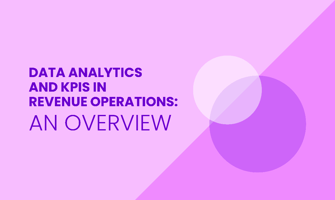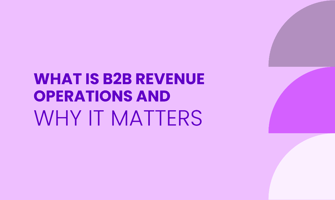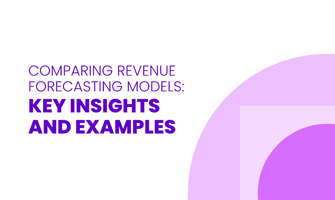Data analytics has emerged as a cornerstone in steering strategic maneuvers and optimizing Revenue...
Forecasting and Analyzing Revenue in RevOps
When it comes to Revenue Operations (RevOps), precision in forecasting and analysis is key for proactive and data-driven decision-making. In an environment where 35% of leaders still rely on manual processes like spreadsheets for forecasting, the call for efficiency and accuracy couldn't be more pressing.
The agility of a business in today's market hinges on its ability to project future earnings and make data-driven decisions. By integrating machine learning and AI-driven methods, organizations can move from static predictions to dynamic, responsive strategies that identify and leverage market opportunities.
At 180ops, we understand the critical nature of harnessing data to predict, analyze, and optimize revenue streams. Here we provide an overview of the role of forecasting and analyzing revenue.
The Role of Forecasting in Revenue Operations
Importance of Forecasting and Analyzing Revenue in RevOps
Deconstructing the intricate web of Revenue Operations requires not just keen observation but also predictive precision. Forecasting acts as the compass that guides these interconnected parts toward sustainable growth.
Solid forecasting distinguishes flukes from trends, manages resources effectively, and anticipates market shifts. In RevOps, accurate forecasting is pivotal, providing the basis from which all strategies are crafted.
In RevOps, accurate forecasting is pivotal, providing the basis from which all strategies are crafted
The Role of Revenue Forecasting in Guiding Strategic Decisions
Strategic decisions shouldn't rely on gut feeling or intuition alone; they need a foundation of solid data and reliable forecasts. With the predictive analytics market expected to reach $28 billion by 2026, the trajectory toward data-informed decisions is clear.
In navigating the complexities of the corporate landscape, a forecast acts as a lighthouse, providing guidance through data insights into customer behaviors, market conditions, and the efficiency of sales processes. It's this clarity that enables executives to deploy strategies not just effectively, but also with the agility required in a constantly evolving market.
For organizations looking to revolutionize their Revenue Operations, we at 180ops offer data-driven solutions. Our platform enhances strategic decisions, laying out a comprehensive understanding from the granular level of sales forecasting to the overarching narrative of revenue projections.
![]()
Predictive Analytics and Revenue Forecasting
The inception of predictive analytics in the realm of RevOps has marked a turning point for making informed decisions about the future. Predictive analytics stones on the path to anticipating business trends, consumer behaviors, and potential outcomes with an unprecedented level of precision. This technology harnesses historical data, statistical algorithms, and machine-learning techniques to predict future events.
Predictive analytics serves as a catalyst that transforms raw data into a strategic asset. It equips teams with the ability to understand various scenarios, calculate risks, and make calculated, agile responses to market shifts, ultimately fostering a more predictable revenue stream.
Through advanced forecasting software, companies can move away from the rigidity of spreadsheets and confidently stride towards a data-rich trajectory defined by actionable insights.
Predictive analytics serves as a catalyst that transforms raw data into a strategic asset, empowering teams to foster a more predictable revenue stream.
How AI and Machine Learning Transformed Revenue Forecasting
AI and Machine Learning have greatly improved revenue forecasting accuracy in businesses. These technologies serve as the engines of insight for RevOps, churning through complex data sets to surface patterns and predictions that the human eye might miss.
By analyzing historical data, these technologies can predict future KPIs more precisely. Techniques like regression analysis, predictive modeling, and forecasting software play a key role in incorporating AI and Machine Learning into revenue forecasting processes.
This not only enhances prediction accuracy but also streamlines the forecasting method for teams involved in Revenue Operations. By using machine learning algorithms to analyze metrics such as win rate, sales cycle length, and opportunity stage forecasting, organizations can generate more reliable sales forecasts. This, in turn, helps in making informed decisions to drive growth and maximize sales revenues.
Machine learning algorithms, in particular, are pivotal in adapting these forecasts based on new data inputs, learning as they go, and fine-tuning their predictions for increased accuracy. This evolution from static to dynamic forecasting models is critical when industries experience rapid change or when businesses scale at an accelerated pace.
At 180ops, we harness the transformative power of AI and machine learning to arm decision-makers with the tools necessary for crafting foresight-driven strategies that drive growth and redefine customer value. In the hands of our clients, AI becomes not just a tool, but a strategic ally in the quest for revenue maximization.
The Importance of Data Integration and Management
Data Integration
A seamless flow of integrated data is the lifeblood of any successful RevOps strategy. Without it, analysis becomes incomplete, leading to misleading information for decision-making.
Data integration and management support the whole structure of Revenue Operations, allowing for an overarching view of customer interactions, sales funnels, and performance metrics.
By combining data from various sources like CRM systems, historical sales forecasting, macroeconomic information, and sales cycle data, teams can predict the future directions better. This integration helps in understanding sales metrics, growth trends, and opportunity stage forecasting.
It also leads to more reliable predictions of key metrics such as sales pipelines, deal data, and win probabilities. These insights help the company in making informed decisions on business strategies and resource allocation based on historical trends and predictions.
Data Quality & Management
Having a large amount of data is not enough. It must also be of high quality and carefully managed to glean the most meaningful insights. A robust data management system is needed to ensure that data is cleansed, categorized, and channeled timely and accurately, providing a trustworthy foundation for predictive analyses.
As only 22% of leaders strongly agree they have the right data to forecast accurately, data management provides competitive opportunities for companies.
At 180ops, we pride ourselves on our Minimum Viable Data approach, making sure that businesses can achieve maximum clarity from a concise set of data points. This philosophy not only streamlines the decision-making process but also enhances the joy of discovery in work.
Data integration and management support the whole structure of Revenue Operations, allowing for an overarching view of customer interactions, sales funnels, and performance metrics.
Analytical Tools and Technologies in RevOps Analysis and Forecasting
![]()
Various analytical tools can be used for revenue forecasting, each with its unique features and applications. These tools, powered by AI and machine learning, process and parse through data, transforming it into a strategic map for businesses to follow.
Using solutions like regression analysis, machine learning, and forecasting software helps teams predict future sales revenues accurately based on historical data.
Here's a list of some commonly used tools for revenue forecasting:
Revenue Intelligence Tools: Revenue Operations revenue intelligence platform is designed to enhance clarity and efficiency in revenue-related operations for enterprises. Utilizing advanced AI and machine learning technologies, it aims to provide actionable insights, enabling businesses to make informed decisions about what to sell, to whom, when, and why.
Advanced Excel Models: Excel remains one of the most accessible and widely used tools for revenue forecasting. Advanced Excel features like PivotTables, statistical functions, and the Solver add-in can be used to analyze historical data and project future revenues.
Google Sheets and Add-ons: Similar to Excel, Google Sheets offers collaboration capabilities and add-ons like Google Analytics and Supermetrics, which can pull data directly into your spreadsheet for analysis.
Time Series Analysis Software:
SAS (Statistical Analysis System): Offers extensive capabilities for advanced analytics, multivariate analyses, business intelligence, data management, and predictive analytics.
SPSS (Statistical Package for the Social Sciences): Widely used for statistical analysis in social science, SPSS is also valuable for time series analysis in revenue forecasting.
Business Intelligence (BI) Tools:
Tableau: Known for its data visualization capabilities, Tableau also provides robust forecasting features that allow businesses to create visual forecasts based on historical data.
Power BI by Microsoft: A collection of software services, apps, and connectors that work together to turn unrelated sources of data into coherent, visually immersive, and interactive insights.
Looker: Now part of Google Cloud, Looker supports data exploration and insight generation, and it can be used for revenue forecasting by analyzing historical data trends.
Enterprise Resource Planning (ERP) Systems:
SAP: Offers advanced analytics that integrate with your existing ERP system, providing detailed insights and forecasting capabilities.
Oracle NetSuite: A cloud-based ERP solution with built-in business intelligence tools that can be used for revenue forecasting and analysis.
Customer Relationship Management (CRM) Tools:
Salesforce: Offers customizable forecasting tools that allow businesses to predict revenue based on sales pipelines and historical performance.
HubSpot Sales Hub: Provides sales forecasting tools that can help in projecting future revenue based on deals in the pipeline and historical conversion rates.
Machine Learning and AI Platforms:
IBM Watson: Offers AI and machine learning capabilities for predictive analytics, which can be applied to revenue forecasting.
Google Cloud AI Platform: Provides tools and services for machine learning and other AI applications, allowing businesses to build sophisticated forecasting models.
Financial Planning Software:
Anaplan: Provides a cloud platform for business planning, which includes revenue forecasting as a key feature.
Adaptive Insights (now part of Workday): Offers business planning solutions that include revenue forecasting, allowing for scenario planning and what-if analyses.
These tools offer metrics on growth, win rate, and opportunity stage forecasting, allowing businesses to strategize effectively. For example, analyzing sales cycle data and lead value forecasting helps sales teams identify leads with the highest win probability and average deal size. This information aids in pipeline forecasting and improving sales projections.
At 180ops, we offer an enterprise revenue intelligence suite that enables businesses to view their operations through the lens of precision analytics. Our solutions serve to connect disparate points of data, applying advanced algorithms that unravel trends and unlock patterns. With these tools, sales forecasting, pipeline analysis, and opportunity stage forecasting evolve from daunting challenges into manageable, insightful processes.
Metrics and KPIs in Revenue Forecasting
In the pursuit of a well-oiled RevOps machine, key performance indicators (KPIs) and metrics are indispensable gauges of success. The strategic usage of these metrics unlocks the door to data-driven decisions and precision-targeted initiatives.
These metrics cover aspects like
Sales and Marketing Effectiveness
Sales Growth: Measures the increase or decrease in sales revenue over time, indicating market demand and business growth.
Lead Conversion Rate: The percentage of leads that convert into paying customers, showing the effectiveness of sales and marketing strategies.
Customer Acquisition Cost (CAC): The cost associated with acquiring a new customer, highlighting the efficiency of marketing and sales efforts.
Market Penetration: The extent to which a product or service is sold compared to the total estimated market, indicating market share and competitive positioning.
Pipeline Value: The total value of all opportunities in the sales pipeline.
Pipeline Growth Rate: The rate at which the pipeline value is growing over time, indicating the health of future revenue prospects.
Customer Relationship and Value
Average Revenue Per Unit (ARPU): The average revenue generated per unit or customer, indicating the value derived from each customer.
Customer Lifetime Value (CLV): Predicts the total revenue a business can expect from a single customer account over the duration of their relationship, showing the long-term value of customers.
Churn Rate: The percentage of customers who discontinue their subscriptions or repeat purchases within a certain period, indicating customer retention and satisfaction.
Financial Health and Efficiency
Revenue Run Rate: Projects future revenue over a period based on current revenue data, useful for forecasting and planning.
Gross Margin: The difference between revenue and the cost of goods sold, expressed as a percentage of revenue, indicating profitability and pricing efficiency.
Accounts Receivable Turnover: Measures how quickly the company collects cash from credit sales, indicating the efficiency of credit and collection processes.
Product and Market Insights
Product or Service Mix: Analyzes the revenue contribution of different products or services, providing insights into market preferences and product performance.
Sales Pipeline Coverage: The size of the sales pipeline relative to the revenue target, indicating the potential to meet future revenue goals.
Market and External Metrics
Market Growth Rate: The growth rate of the market in which the business operates. A growing market presents opportunities for revenue growth.
Competitor Pricing and Offerings: Understanding how competitors price their products and their value propositions can influence pricing strategies and potential revenue.
Economic Indicators: Broader economic trends can affect customer purchasing power and willingness to spend, impacting revenue forecasts.
By studying these metrics, teams can predict future revenues and spot growth opportunities in the sales process.
Through the strategic use of metrics and KPIs, data can be turned into a lever for growth and a beacon for foresight.
Best Practices and Solutions for Revenue Forecasting in RevOps
![]()
At 180ops, we uphold key principles that bolster the forecasting process: ensuring data integrity, embracing technological advancements, and fostering cross-functional collaboration.
Here are key strategies to improve revenue forecasts:
Leverage Accurate and Up-to-date Data
Data Quality: Ensure the data used for forecasting is accurate, complete, and consistently updated to reflect the most current state of the business.
Comprehensive Data Sources: Utilize data from all relevant sources, including CRM systems, marketing automation tools, customer feedback, and financial systems.
Implement Robust Forecasting Models and Tools
Choose the Right Model: Use forecasting models that suit your business type, sales cycle, and market dynamics. Common models include historical forecasting, regression analysis, and cohort analysis.
Use of Technology: Leverage advanced tools and software that can integrate data from various sources, automate calculations, and provide real-time insights.
Account for Market and External Factors
Market Trends: Stay informed about market conditions, industry trends, and economic indicators that could affect your revenue.
Competitive Landscape: Consider the impact of competitors' actions, pricing strategies, and market positioning on your revenue potential.
Plan for Various Scenarios
Scenario Planning: Develop multiple forecasting scenarios, including best-case, worst-case, and most likely scenarios, to prepare for different market conditions and business situations.
Contingency Planning: Create contingency plans for unexpected events, ensuring the organization can respond quickly to changes.
Monitor and Update Forecasts Regularly
Continuous Review: Regularly review and adjust forecasts based on actual sales performance, market changes, and new business developments.
Feedback Loops: Implement feedback mechanisms to learn from forecasting inaccuracies and improve future predictions.
Conclusion
Forecasting and analysis stand as indispensable tools for any business seeking to thrive amidst volatility. Through strategic application of predictive analytics, AI, and machine learning, revenue forecasting transforms from an educated guess into an instrumental component of planning and execution.
In Revenue Operations, the path to precision and predictability is paved by data, analytics, and the wisdom to harness them both.
At 180ops, our purpose is to guide businesses towards achieving such transformative clarity. Our suite of revenue intelligence tools, underpinned by a profound customer and market-centric perspective, offers a method for companies to maximize their data. By moving from disparate systems to a unified view of operations, our clients unlock the power of transforming data into actionable insights.
FAQ
How can predictable forecasting enhance the effectiveness of RevOps solutions?
Predictable forecasting provides a stable foundation for planning and decision-making in RevOps, enabling better resource allocation, streamlined operations, and aligned cross-functional strategies, leading to improved efficiency and outcomes.
What role do RevOps leaders play in ensuring accurate sales forecasts?
RevOps leaders orchestrate the alignment of sales, marketing, and customer success teams, leverage data analytics, and implement advanced forecasting tools and methodologies to ensure the accuracy and reliability of sales forecasts.
How can multivariable forecasting contribute to more accurate sales forecasts in RevOps?
Multivariable forecasting considers various factors such as market trends, customer behaviors, and economic indicators, allowing for a more comprehensive analysis. This approach provides deeper insights and more precise predictions, enhancing the accuracy of sales forecasts in RevOps.




